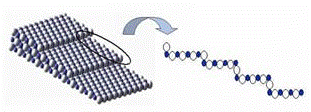Department of Chemistry
Document Type
Article
Date of this Version
September 2006
Abstract
Cleaved NiO(1 0 0) surfaces were imaged with atomic force microscopy (AFM) to determine defect concentrations and morphology. Random (0 1 0) and (0 0 1) oriented steps, which have been previously characterized, were the most common defect observed on the cleaved surface and formed with step heights in multiples of 2.1 Å, the Ni–O nearest-neighbor distance, and terrace widths in the range of 25–100 nm. In addition, the surface showed novel mesoscale (~0.5–2 μm) square pyramidal defects with the pyramid base oriented along (1 0 0) symmetry related directions. Upon etching, the pyramidal defects converted to more stable cubic pits, consistent with (1 0 0) symmetry related walls. The square pyramidal pits tended to cluster or to form along step edges, where the weakened structure is more susceptible to surface deformations. Also, a small concentration of square pyramidal pits, oriented with the base of the pyramid along (0 1 1), was observed on the cleaved NiO surfaces. For comparison purposes, chemical mechanical polished (CMP) NiO(1 0 0) substrates were imaged with AFM. Defect concentrations were of comparable levels to the cleaved surface, but showed a different distribution of defect types. Long-ranged stepped defects were much less common on CMP substrates, and the predominant defects observed were cubic pits with sidewalls steeper than could be accurately measured by the AFM tip. These defects were similar in size and structure to those observed on cleaved NiO(1 0 0) surfaces that had been acid etched, although pit clustering was more pronounced for the CMP surfaces.



Comments
Published in Surface Science 600:17 (September 1, 2006), pp. L229–L235. doi:10.1016/j.susc.2006.06.005 Copyright © 2006 Elsevier B.V. Used by permission. http://www.sciencedirect.com/science/journal/00396028